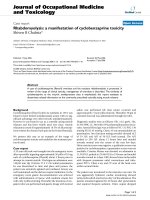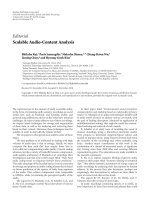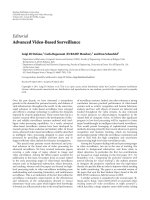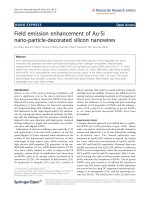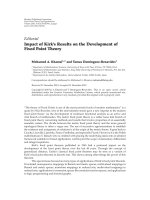Báo cáo hóa học: " Editorial Super-Resolution Enhancement of Digital Video" doc
Bạn đang xem bản rút gọn của tài liệu. Xem và tải ngay bản đầy đủ của tài liệu tại đây (987.56 KB, 3 trang )
Hindawi Publishing Corporation
EURASIP Journal on Advances in Signal Processing
Volume 2007, Article ID 20984, 3 pages
doi:10.1155/2007/20984
Editorial
Super-Resolution Enhancement of Digital Video
Russell C. Hardie,
1
Richard R. Schultz,
2
and Kenneth E. Barner
3
1
Department of Electrical and Computer Engineering, University of D ayton, 300 College Park, Dayton,
OH 45469-0026, USA
2
Department of Electrical Engineering, University of North Dakota, Upson II Room 160, P.O. Box 7165,
Grand Forks, ND 58202-7165, USA
3
Department of Electrical and Computer Engineering, University of Delaware, 140 Evans Hall, Newark,
DE 19716-3130, USA
Received 10 June 2007; Accepted 10 June 2007
Copyright © 2007 Russell C. Hardie et al. This is an open access article distributed under the Creative Commons Attribution
License, which permits unrestricted use, distribution, and reproduction in any medium, provided the original work is properly
cited.
When designing a system for image acquisition, there is gen-
erally a desire for high spatial resolution and a wide field
of view. To satisfy these competing requirements, a camera
system typically must employ small f -number optics, which
produces an image with very high spatial-frequency band-
width at the focal plane. To avoid aliasing caused by under-
sampling, the corresponding focal plane array (FPA) must be
sufficiently dense. However, cost and fabrication complexi-
ties may make this impractical. More fundamentally, smaller
detectors capture fewer photons, which can lead to poten-
tially severe noise levels in the acquired imagery. Consider-
ing these factors, one may choose to accept a certain level of
undersampling or to sacrifice some optical resolution and/or
field of view.
In super-resolution (SR) image reconstruction, postpro-
cessing is used to obtain images with resolutions that go be-
yond the conventional limits of the uncompensated imag-
ing system. In some systems, the primary limiting factor
is the optical resolution of the image in the focal plane
as defined by the cut-off frequency of the optics. We use
the term “optical SR” to refer to SR methods that aim to
create an image with valid spatial-frequency content that
goes beyond this cut-off frequency. Such techniques typi-
cally must rely on extensive a priori information. In other
image acquisition systems, the limiting factor may be the
density of the FPA, subsequent postprocessing requirements,
or transmission bit rate constraints that require data com-
pression. We refer to the process of overcoming the lim-
itations of the FPA in order to obtain the full resolu-
tion afforded by the selected optics as “detector SR.” Some
methods may seek to perform both optical and detector
SR.
Detector SR algorithms gener ally process a set of low-
resolution aliased frames from a video sequence to produce
a high-resolution frame. When subpixel relative motion is
present between the objects in the scene and the detector ar-
ray, a unique set of scene samples is acquired for each frame.
This provides the mechanism for effectively increasing the
spatial sampling rate of the imaging system without reduc-
ing the physical size of the detectors.
With the proliferation of digital imaging and video, SR
has become a rapidly growing field. Recent advances in SR in-
clude innovative algorithms, generalized methods, real-time
implementations, and novel applications. The purpose of
this special issue is to present leading research and develop-
ment in the area of super-resolution image reconstruction as
applied to digital video. Specific topics addressed in this spe-
cial issue include image registration, regularization, photo-
metric diversity, detector nonuniformity, compression, opti-
cal design, and perfor m ance metrics.
Two of the papers in this special issue address topics
related to subpixel image registration for SR. In particu-
lar, the paper by L. C. Pickup et al. presents a joint regis-
tration and SR approach in a Bayesian framework, as well
as an alternative approach using Bayesian marginalization
over unknown registration parameters. The paper by M. Das
Gupta et al. presents a supervised learning based approach
to subpixel motion estimation for video super-resolution.
Two other papers in this issue explore various cost functions
and regularization methods for SR. V. Patanavijit and S. Ji-
tapunkul use a Lorentzian error norm for measuring the dif-
ference between the projected estimate of the high-resolution
image and each low-resolution image. They also employ
both Tikhonov and Lorentzian-Tikhonov regularization to
2 EURASIP Journal on Advances in Signal Processing
remove artifacts from the SR estimate and improve the con-
vergence rate of the corresponding iterative algorithms. The
paper by M. Ng et al. employs total variation regularization
in the reconstruction model, as a variant on the more tradi-
tional regularized least-squares-based techniques.
Images used for SR may be affected by factors other
than the traditional aliasing, blur, and noise that must
be addressed. For example, multiple images may be cap-
tured under photometric variation. This may include chang-
ing external illumination conditions and/or camera cali-
bration differences. M. Gevrekci and B. K. Gunturk pro-
pose a novel nonlinear technique for addressing these vari-
ations. Another problem often encountered, particularly for
infrared imagers, is detector nonuniformity. R. C. Hardie
and D. R. Droege present a Bayesian approach for simultane-
ously estimating detector nonuniformity parameters and SR
imagery.
SR with image compression is another important area
addressed in this issue. L. Shao presents an adaptive reso-
lution up-conversion algorithm that is robust to compres-
sion artifacts. The method is based on classification of local
image patterns and uses a least-mean-square training proce-
dure. The paper by N. Maor et al. considers compression at
the source for digital camcorders. Their system is based on a
variable spatiotemporal sampling strategy, which combines
infrequent high-resolution frames with more frequent low-
resolution frames.
As SR techniques become more prevalent, optical designs
are starting to be influenced by the potential for SR postpro-
cessing. The paper by N. A. Ahuja and N. K. Bose explores
the design of an optical system with a large field of view us-
ing a lenslet array, applying multiframe SR techniques to the
resulting images. The proposed system is capable of realizing
both a specified resolution and specified field of view. Finally,
the paper by A. van Eekeren et al. explores performance met-
rics for SR on real-world data. Their proposed metric is based
on an observer task referred to as triangle orientation dis-
crimination. This provides a useful means for quantitatively
comparing the performance of SR reconstruction methods
under varying conditions.
We sincerely hope that you enjoy and learn from this
collection of SR papers. SR from digital video is a relatively
new field, in only its third decade of existence. There is no
doubt that as imaging sensor technologies, optical fabri-
cation techniques, and computational algorithms mature,
SR will find its way into digital video products such as
cameras and digital cable set-top boxes. These papers on
the fundamental SR topics of image registr a tion, regu-
larization, photometric diversity, detector nonuniformity,
compression, optical design, and performance metrics serve
as pioneers in the dynamic and evolving field of SR image
reconstruction research and development. We are proud t o
present them to the image and video processing research
community.
Russell C. Hardie
Richard R. Schultz
Kenneth E. Barner
Russell C. Hardie graduated magna cum
laude from Loyola College in Baltimore
Maryland in 1988 with a B.S. degree in
engineering science. He obtained his M.S.
and Ph.D. degrees in elect rical engineering
from the University of Delaware in 1990
and 1992, respectively. Dr. Hardie served as
a Senior Scientist at Earth Satellite Corpo-
ration in Maryland prior to his appoint-
ment at the University of Dayton in 1993.
He is currently a Full Professor in the Department of Electrical
and Computer Engineering and holds a joint appointment with
the Electro-Optics Program. Along with several collaborators, Dr.
Hardie received the Rudolf Kingslake Medal and Prize from SPIE
in 1998 for work on multiframe image resolution enhancement al-
gorithms. Dr. Hardie recently received the University of Dayton’s
Top University-Wide Teaching Award, the 2006 Alumni Award in
Teaching. In 1999, he received the School of Engineering Award of
Excellence in Teaching at the University of Dayton and was the re-
cipient of the first Professor of the Year Award in 2002 from the
student chapter of the IEEE at the University of Dayton. His re-
search interests include a wide variety of topics in the area of digital
signal and image processing. His research work has focused on im-
age enhancement and restoration, pattern recognition, and medical
image processing.
Richard R. Schultz serves as an Associate
Professor and Chair of electrical engineer-
ing at the University of North Dakota
(UND) in Grand Forks. Dr. Schultz received
the B.S.E.E. degree from UND in 1990 and
the M.S.E.E. and Ph.D. degrees from the
University of Notre Dame in 1992 and 1995,
respectively. He joined the UND faculty in
1995, and his teaching and research inter-
ests are in aerospace payload and sensor de-
velopment, control systems, digital image and video processing,
embedded systems design, student-generated intellectual property,
systems engineering, and technology entrepreneurship. Prior to his
appointment as Department Chair, Dr. Schultz served as a Copro-
ject Director of the North Dakota Experimental Program to Stim-
ulate Competitive Research (EPSCoR), from Januar y 2004 through
August 2005. In this role, he had the unique opportunity of foster-
ing interdisciplinary campus and statewide research, development,
and commercialization partnerships. Dr. Schultz is currently in-
volved in the Unmanned Aircraft Systems Center of Excellence at
the University of North Dakota, an interdisciplinary research cen-
ter that includes the John D. Odegard School of Aerospace Sciences,
the School of Engineering and Mines, the College of Nursing, and
the Department of Psychology. Within this center, Dr. Schultz helps
supervise the design of unmanned aerial vehicle payloads and sen-
sors, conducts research on the enhancement of surveillance digital
video for automatic target recognition and tracking, and guides the
development of sense and avoid technologies for unmanned air-
craft.
Kenneth E. Barner received his B.S.E.E.
degree from Lehigh University, Bethle-
hem, Pa, USA in 1987. He received the
M.S.E.E. and Ph.D. degrees from the Uni-
versity of Delaware, Newark, Delaware, in
1989 and 1992, respectively. He is cur-
rently a Professor in the Department of
Electrical and Computer Engineering at
the University of Delaware. He was the
Russell C. Hardie et al. 3
cochair of the 2001 IEEE-EURASIP Nonlinear Signal and Image
Processing (NSIP) Workshop and a Guest Editor for a special is-
sue of the EURASIP Journal of Applied Signal Processing on Non-
linear Signal and Image Processing. He is a Member of the Non-
linear Signal and Image Processing Board and is coeditor of the
book Nonlinear Signal and Image Processing: Theory, Methods,
and Applications, CRC Press, 2004. He was the Technical Program
cochair for ICASSP 2005 and is currently serving on the IEEE Signal
Processing Theory and Methods (SPTM) and IEEE Bio-Imaging
and Signal Processing (BISP) technical committees. Dr. Barner has
served as an Associate Editor of the IEEE Transactions on Signal
Processing, the IEEE Transaction on Neural Systems and Rehabil-
itation Engineering, and the IEEE Signal Processing Magazine. He
is currently the Editor-in-Chief of the journal Advances in Human-
Computer Interaction, a Member of the Editorial Board of the
EURASIP Journal of Applied Signal Processing, and is serving as
a Guest Editor for that journal on the Empirical Mode Decompo-
sition and the Hilbert-Huang Transform special issue. His research
interests include signal and image processing, robust signal pro-
cessing, nonlinear systems, communications, human-computer in-
teraction, haptic and tactile methods, and universal access.
